Japan Wood Products
Prices
Dollar Exchange Rates of
27th June 2013
Japan Yen 99.15
Reports From Japan
JCER Outlook signals caution on inflation prospects
Analysts at Japan Center for Economic Research (JCER) are more cautious in
their forecasts for the Japanese economy than the Bank of Japan (BoJ), as is
evident in the latest JCER Outlook Report.
www.jcer.or.jp/eng/pdf/sa154-eng2.pdf
This report recommends caution regarding the likely effectiveness of the
“virtuous circle of production, income, and spending” and inflation
expectations.
The JCER report says “virtuous circle was one of the key terms used during
the previous economic recovery in the early 2000s.
However at that time terms of trade losses meant that the mechanism did not
function effectively and although GDP moved from negative to positive, this
was not enough to lift the economy out of its deflationary spiral”.
The similarity is drawn with conditions in early 2000 and today in Japan
where import bills are rising sharply because of the weaker yen and the
deficit is widening.
The JCER has doubts about inflation expectations also asking, do
expectations cause inflation, or does actual inflation uplift expectations?
Compounding the difficulty in making projections is the planned increase in
consumption tax.
The JCER says the looming increase in tax will result in ‘last minute
demand’ growth which could exceed expected levels such that afterwards there
is a sharp decline in consumer and business spending, perhaps even enough to
cause a slump in 2014.
Exports to US and China increased in May
Industrial output in Japan strengthened in May moving to a level not
recorded since 2011. The Cabinet Office report also shows retail sales grew
and the consumer price index remained flat bringing to an end the continuous
decline over the past six months.
Japan's exports also improved in May growing by around 10 percent, aided by
a weak yen and the better stability and modest improvement in overseas
demand. Exports to the US rose 16 percent from a year earlier while
shipments to China rose 8 percent.
This performance is seen as evidence that the efforts of the government to
break the deflationary spiral may be working.
But the weaker yen added to Japan’s already massive energy import costs,
leaving the country with a US$10 bil. trade deficit. However, analysts
consider the net effect of the weaker yen as offering promise for future
industrial expansion so remain positive on prospects for the economy.
Housing starts surge as buyers act to beat consumption tax hike
May housing starts in Japan totaled 79,751 a nearly 15% rise from April
bringing annualized starts to 1,027,000 starts, well above the forecast
950,000 units. May orders received by the 50 top construction companies in
Japan rose 26% year on year
The full details of housing starts in Japan can be found at:
http://www.e-stat.go.jp/SG1/estat/NewListE.do?tid=000001016966
Analysts attribute the steep rise as a reaction of buyers to the anticipated
increase in consumption tax due next year and to the desire of buyers to
secure mortgages at the cheapest rate possible.
Banks providing home loans in Japan are already imposing increased interest
rates for fix rate mortgages.
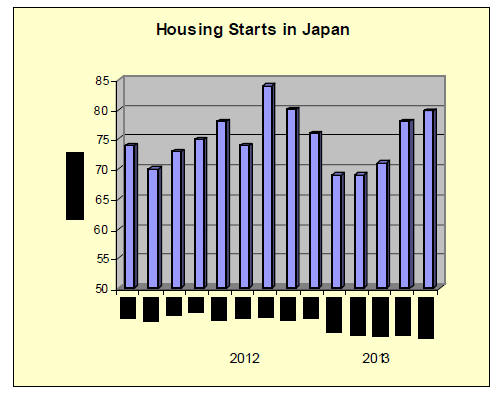
Japan’s tropical log imports forecast to fall sharply in 2013
The Japan Foreign Timber General Supply and Demand Liaison Conference has
released forecasts for timber imports in 2013.
While total demand for logs in 2013 is forecast to be as much as it was in
2012, demand for tropical logs is expected to fall by around 40% largely
because of the closure of one Japan’s major tropical plywood mill.
Statistics for first quarter imports shown below bear out the forecasts by
the Conference.

North American logs are utilised in Japan for sawnwood production and
2013 imports are expected to rise around 3%. Demand for Russian logs and
radiate pine logs is estimated to be about the same level as in 2012.
Japan imports significant volumes of tropical plywood and demand in 2013 is
forecast to be higher than in 2012 driven by increased activity in the
construction and house building sectors.

Trade news from the Japan Lumber Reports (JLR)
The Japan Lumber Reports (JLR), a subscription trade journal published
every two weeks in English, is generously allowing the ITTO Tropical Timber
Market Report to extract and reproduce news on the Japanese market.
The JLR requires that ITTO reproduces newsworthy text exactly as it appears
in their publication.
For the JLR report please see:
http://www.n-mokuzai.com/modules/general/index.php?id=7
Canadian minister protests Wood Use Point System
The minister of the Canadian embassy in Tokyo in charge of commerce made
some speech at the reception of the Wood Truss Association and mentioned
that the Wood Use Point System is unfair system in favor of domestic wood.
The system narrows selection of lumber and method for house builders and may
force higher cost wood. Japanese house buyers should have right to select
method and
materials they like in house building but the System excludes imported wood,
which narrows options for the buyers.
This may conflict with WTO rules and may be against the Prime Minister’s
policy to promote free trade with foreign countries. To protect consumers’
interest, the system should include imported wood.
Canadian wood is highly evaluated in quality for the prices and has been
widely used in Japan for many years.
Downward projection on tropical hardwood logs
The Japan South Sea Lumber Conference held the regular meeting on June
10th to discuss demand of South Sea and African hardwood logs for 2013.
Total log demand for 2013 is down to 270 M cbms, 28.2% less than 2012
because of shrinking demand in Japan and gaining power of large log
consuming countries like India.
The peak of tropical hardwood logs is 1973 when total imports were 27,314 M
cbms so the imports dropped down to one hundredth in 40 years.
South Sea logs were used for plywood and lumber with smooth surface and
dimensional stability so they were the main materials for construction after
the war and during growing economy days in Japan but the demand started
dropping during 1970s because of log export restriction by producing
countries and violent price fluctuations then Indonesia shifted to
industrialization so import of finished products like plywood increased.
In 1980s, environmental issues became important so log import further
dropped. At the same time, plywood industry in Japan shifted to use softwood
logs so total log import in 1993 decreased down to less than 10,000 M cbms
then down to less than 4,000 M cbms in 1998. In 2012, the total volume was
mere 336 M cbms.
Unlike other imported logs, South Sea log market prices continue soaring in
Malaysia because of exhausting resources and aggressive purchase by India.
Japanese plywood mills are not able to pay competitive prices so that number
of mills using hardwood logs continues declining.
By application, logs for plywood are 215 M cbms, 28.3% less than 2012 and
for lumber are 55 M cbms, 27.6% less so shrinking trend continues.
South Sea (tropical) logs
While log production in Malaysia remains slow and dull, the demand
continues very active by local plywood mills and India so that log
inventories in ports and log yard stay very low.
Log exporters intend to push the export log prices for Japan since log
prices for India are high but the Japanese buyers strongly resist higher
prices because of weakening yen so the negotiations take much longer now.
Some plywood mills in Japan think that log production should improve in late
July so that they buy minimal volume now.
Log prices in Japan are firm. Sabah kapur prices are 13,500 yen per koku CIF
and Sarawak meranti regular are 9,500 yen. Both are 300-400 yen higher than
May.
PNG’s calophyllum logs for plywood are 11,000 yen per koku CIF for June
arrivals.
Plywood mills and lumber mills in Japan are facing inflated cost of not only
logs but other materials like electricity, trucking and adhesive for plywood
so they need to increase the sales prices soon.
Meantime, plywood mills in Malaysia are aggressively procuring logs,
supported by busy plywood orders but log supply is chronically short so that
they even use logs for
export.
Log suppliers, which run plywood mills, send logs to plywood mills if it is
more profitable than exporting logs. This makes supply of small logs tight.
Sarawak meranti regular FOB prices are $305-310 per cbm and meranti small
are $260-270.
Log harvest in Sarawak during January and March this year was 1,904,800 cbms,
about 16% less than the same period of last year.
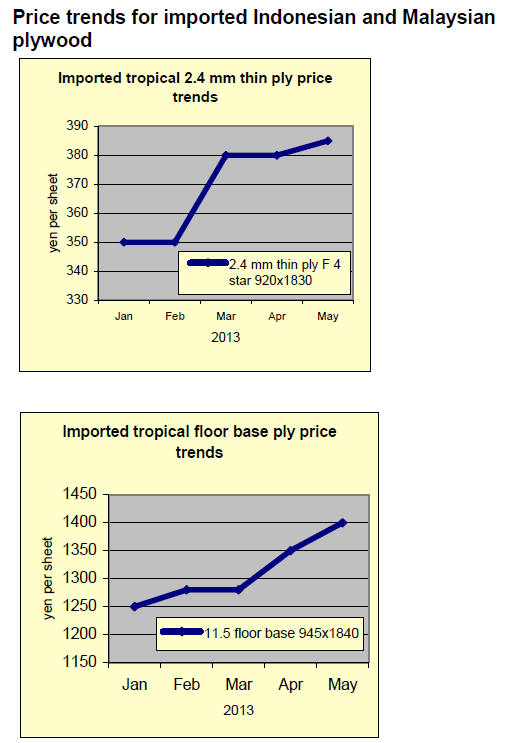

Nankai Plywood builds second plant in Indonesia
Nankai Plywood (Kagawa prefecture), building materials manufacturer, has two
plants in Indonesia. To expand production, it has started building second
plant at Lumadjang to produce laminated lumber of falcate, which will be
completed by the year end.
The Lumadjang plant has started running since October last year. It produces
lumber and laminated lumber from falcate logs and the products are sent to
Gresik plant, which is final assembly plant in Indonesia, where materials
for shelves and cabinets are made.
Nankai Plywood thinks that the demand will expand so that it decided to have
the second plant at Lumadjang.
The first Lumadjang plant has two band saws, planer gang saw and finger
jointer with laminating machines.
The second plant will have the same machines so that laminated lumber
production will be expanded from current 400 cu.m to 800 cu.m.
Gresik plant has capacity of 2,500 cu.m a month to process falcate laminated
lumber for shelf and cabinet board and also ceiling strips and closet bars
made out of meranti and mixed species , which are shipped for the plant in
Japan for final assembly.
Falcata logs are purchased in local open market for Lumadjang plant but the
company has its own plantation in Eastern Java and in two years’ time, it
will start supplying from its own plantation.
Japan’s furniture imports
May 2013 furniture imports
The source and value of Japan’s office, kitchen and bedroom furniture
imports for May 2013 are shown below. Also illustrated is the trend in
imports of office furniture (HS 9403.30), kitchen furniture (HS 9403.40) and
bedroom furniture (HS 9403.50) between 2009 and May 2013.
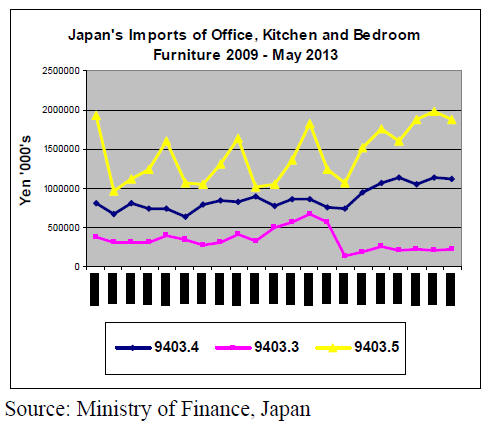
Office furniture imports (HS 9403.30)
In May 2013 Japan’s imports of office furniture from China, Poland and
Malaysia accounted for around 62% of total imports of this category of
furniture.
May imports from China were at around the same level as in April but imports
from Malaysia slumped from yen 30.8mil. to yen 16.5 mil. Imports from EU
member states and Switzerland accounted for 34% of Japan’s office furniture
imports in May.
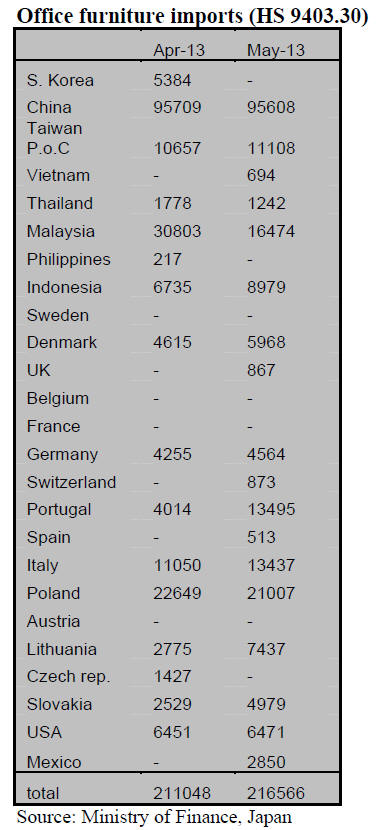
The main EU suppliers were Poland at yen 21 mil. followed by Portugal,
from which imports more than doubled, and Italy at yen 13mil. Office
furniture imports from the EU increased by approx. 34% in May. In May,
Japan’s office furniture imports totaled yen 216 mil. an increase of over
20% from April.
Kitchen furniture imports (HS 9403.40)
Kitchen furniture imports remain the second largest segment of all wooden
furniture imports into Japan after bedroom furniture.
Vietnam continues to be the number one supplier of kitchen furniture to
Japan but in May the value of imports from Vietnam, at yen 327 mil., was
down almost 30% from April.
Three suppliers, Vietnam, Indonesia and China in order of magnitude,
accounted for 76% of total kitchen furniture imports by Japan in May and if
shipments from the Philippines is included, then four suppliers provided 85%
of the total.
May shipments of kitchen furniture from Europe were dominated, once more, by
those from Germany and at yen 68 mil. were almost 50% higher than in April.
Imports during May from Italy fell by around half that in April while, in
contrast, imports of kitchen furniture from the US were the sixth highest of
all the main suppliers.
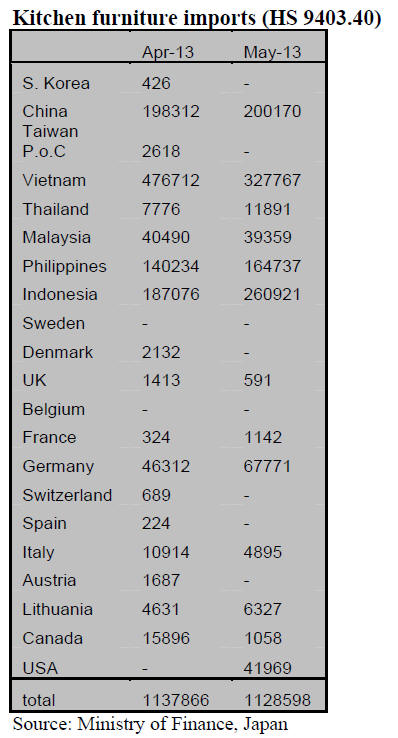
Bedroom furniture (HS 9403.50)
Japan’s imports of bedroom furniture are close to yen 2 bil. every month.
Imports in May fell slightly to yen 1.88 bil. from the yen 1.98 bil. in
April this year.
As in April the top suppliers in May were China and Vietnam which, together
with imports from Malaysia, accounted for around 88% of all wooden bedroom
furniture imports to Japan. Shipments of bedroom furniture to Japan from
China in May were at the same level as in April but shipments from Vietnam
and Malaysia fell 23% and 15% respectively. Imports by Japan from Taiwan
P.o.C and Poland fell significantly and imports from the US were down almost
50%.
Overall, imports of Bedroom Furniture in May were down 5% from levels in
April.
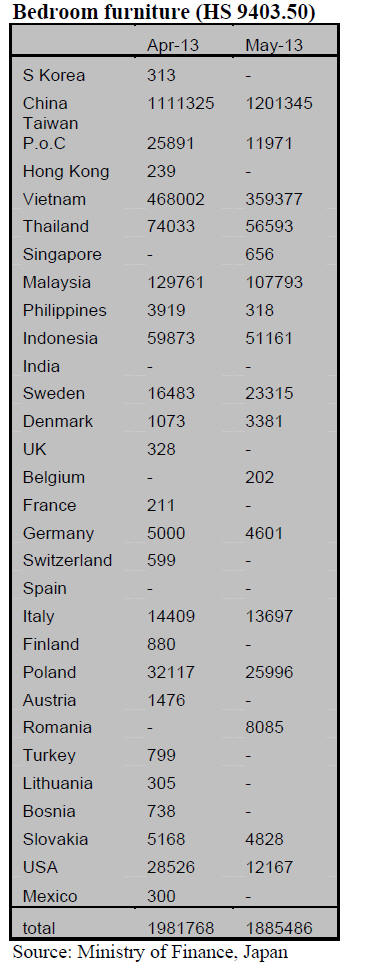
|